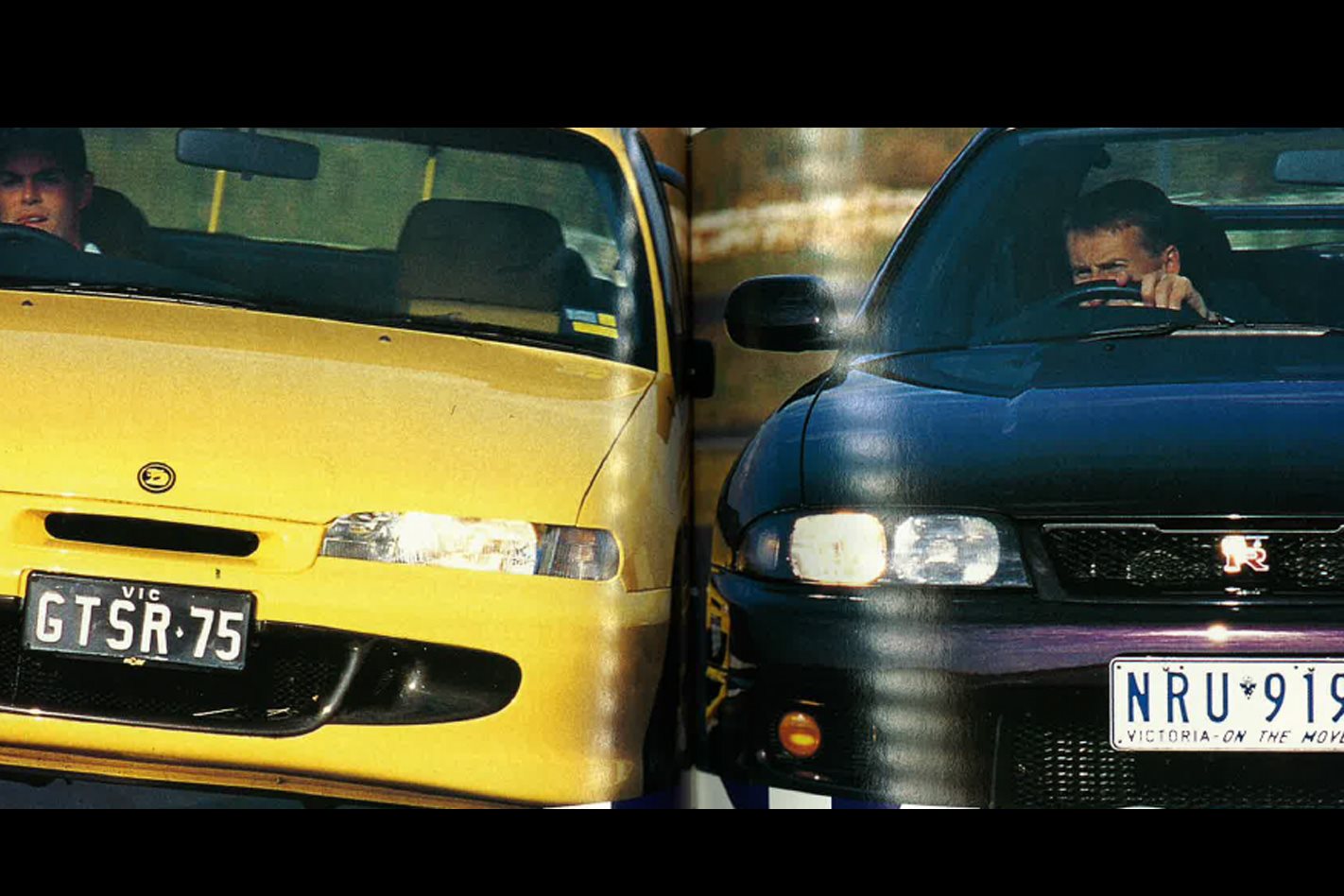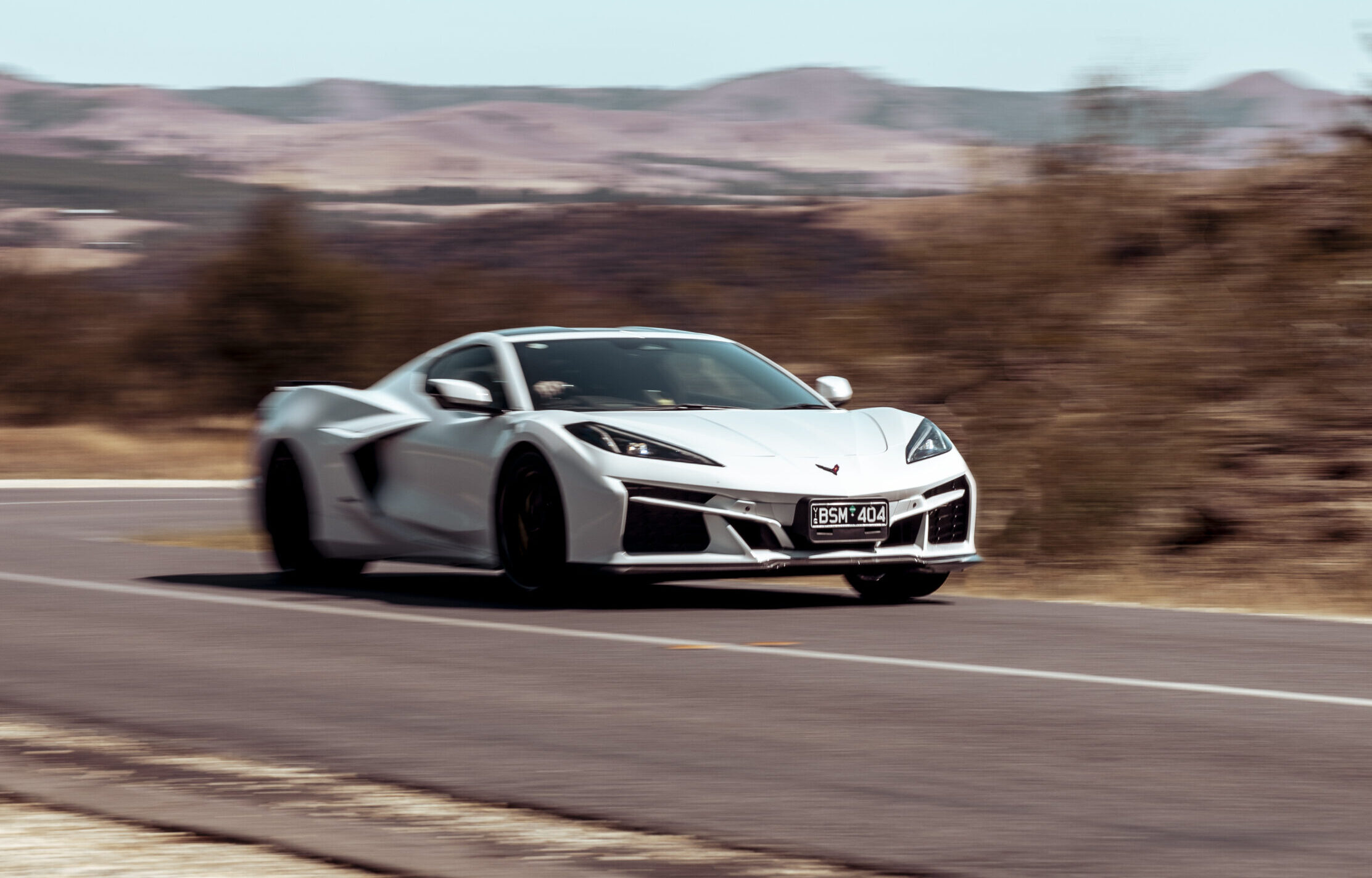Godzilla, once the kick-ass king of Australian touring car racing, is back… back to haunt the memories of all who remember the way it chewed up and spat out our Aussie V8s until the rule makers shot it dead.
This article was originally published in the April 1996 issue of MOTOR.
ln its prime the all-wheel drive, twin-turbocharged Nissan GT-R gobbled two Australian Touring Car Championships and Bathurst trophies as it ripped the heart out of our premier motor sport category with its techno gee-whizery.
While its new-age sophistication and unparalleled speed impressed the minority purists, the majority of fans despised the way the Japanese monster brushed rivals aside with utter contempt. The arrival of the latest incarnation of Godzilla – only this time in road-going and not racing form, and a whole lot meaner by the way – serves as a poignant reminder of the touring car holocaust.
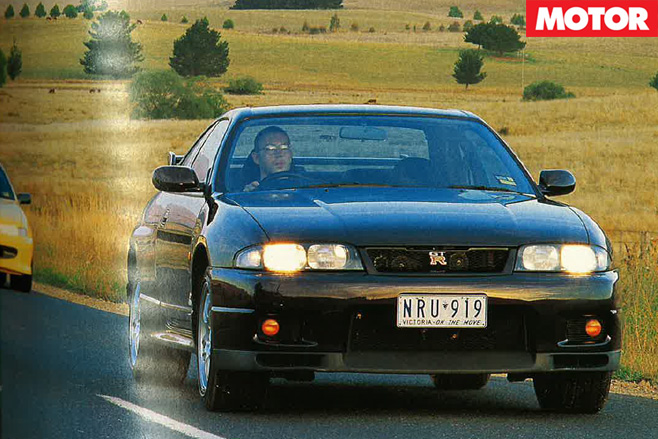
The Japanese rocket wasn’t the only piece of race-inspired road-going machinery prompting salivation. On the other side of the building was the street-legal emulation of the HRT Group A racer in the form of the HSV GTS-R, the first such Holden racer-for-the-road since the bulky Group A VN back in 1990.
There they were: the beast of brawn and tyrant of technology. Radically different in design yet dedicated to the same objective – blistering performance. The ideologies of their creators are so opposed that the fact we’re even able to consider them worthy rivals is staggering.
Yes, it may be five years since the last Holden/Nissan tango, but the song remains the same. Today, the two-step seems unfair. The Commodore’s still a porky ol’ pushrod V8 while the new Nissan has enough ingratiating computer power to fly the space shuttle. Six Million Dollar Man beating up on Aussie Joe Bugner.
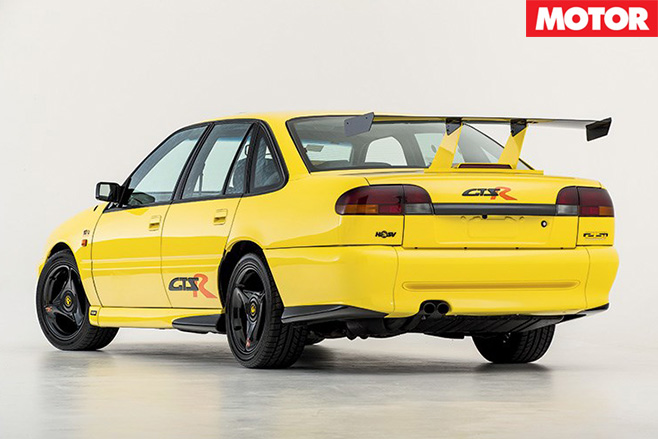
While the visual difference between it and the gutsy GTSi on which it’s based are vast, the mechanical modifications are few: it has the same HRT 215ci stroker engine, optimised (read blueprinted), and with a better breathing exhaust for improved airflow and reduced back pressure. That’s it. Brakes, suspension and gearbox are straight from the GTS bin.
The optimised engine produces an official 226kW at 5000rpm. That’s 303 horsepower in the old money. Perhaps more significantly, it makes 507 of Sir Isaac’s metres of torque at 3500rpm, holding on to 502 of those until 4000rpm. The exhaust also liberates more oomph though exactly how much HSV won’t say. So if you think it goes like buggery, you’re right.

And if Nissan wasn’t so deadly serious with the GT-R you’d dismiss it as a toy, so overwhelming is its intricate design. The techno tour de force shows in the price – while the limited-edition GTS-R (only 75 will be built) costs $76,000 in standard trim and an extra $10,500 with the gun engine, Godzilla II won’t leave you much change out of $190,000. That’s nearly double the price of Godzilla I, but is it twice the car?
A glance down the spec sheet, which looks like a physics professor’s lecture notes, suggests it may well be. The all-new GT-R makes its predecessor’s Buck Rogers technology seem obsolete. The twin-turbocharged in-line six-cylinder engine, four-wheel steer and four-wheel drive set-up have been further perfected by Nissan’s men in white coats to make this car arguably the world’s most cultivated piece of mainstream sports machinery.
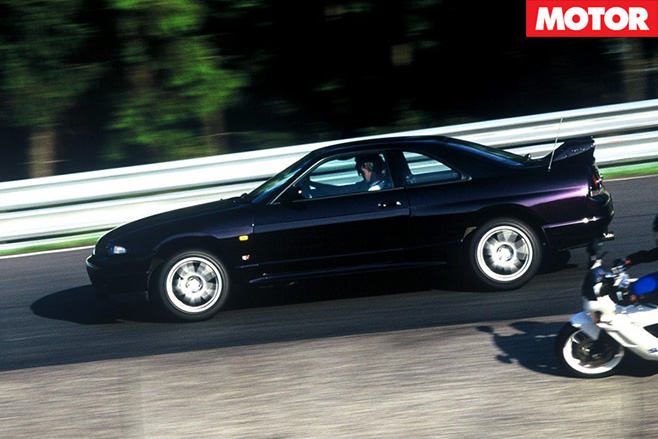
The torque-split 4wd system uses an independent wheel sensor on each corner to measure speed, slippage, braking and sideways force, with the computer acting on that info to vary the amount of drive to each wheel. Left to right, front to rear. Maximum traction. Maximum performance.
The degree of torque split can range from zero to 50 per cent to the front wheels. Nissan calls the black-art 4wd control system ATESSA E-TS PRO, Jap-lish for you need a team off NASA technicians to fix it if it falters.
The four-wheel steer operation is less complex but still daunting, measuring the yaw feedback against pre-set values and making any necessary wheel angle changes in a nanosecond.
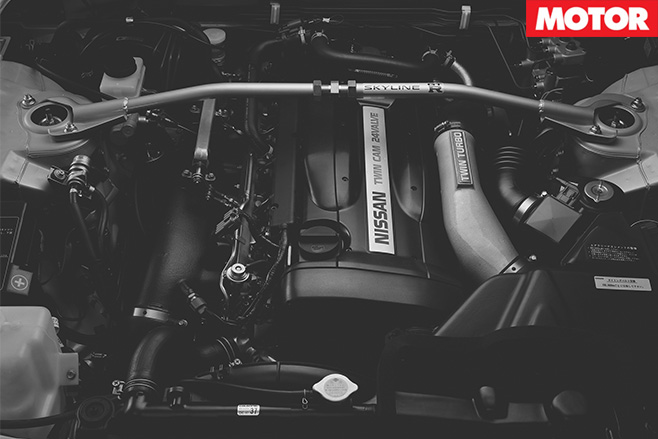
The geometry of the multi-link suspension combined with the tuned-for-racing springs and dampers, not to mention a horizontal strut bracing bar at each end, allegedly enables the GT-R to handle like a train on rails. We would soon find out if that was hype or honesty.
The amount of hardware and plumbing in every nook and cranny of the Nissan will keep technophiles occupied for hours. Every cubic centimetre of space beneath its understated body is chocka with shiny fabrications, little black boxes, hoses and rails. The body shell is a cavity for the world’s most detailed Meccano project.
To look at the GT-R you wouldn’t think it was such a tangled beast. The body, although appearing less slippery and venomous than Godzilla I, is actually more aerodynamic but lacks the killer shimmer. The high and wide front flanks scream muscle; five-spoke alloys whisper cool. That’s where the horn stops.
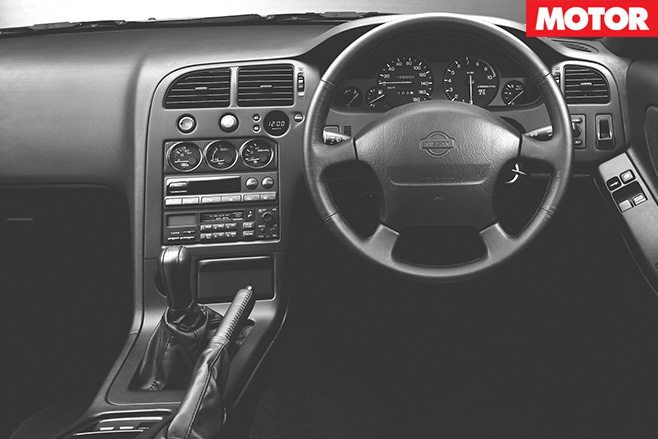
The HSV, on the other hand, is a lesson in how to be ostentatious to the max. The mustardy-yellow duco, rear wing, mass of carbon fibre and gaudy yellow and grey trim make it impossible to slink home quietly. The GTS-R has the show, but importantly, it has the go to match.
It hits home what a gutsy, trusty, refined, world-class fighter the HSV is as we blast down the twisty road etched into Mount Buller on the first day of our two-day gallop with the beasts. Godzilla throws the first punch as the early morning sun filters through the tall bushy gum trees. The patches of bright light and long shadows thrown on to the road create a mesmerising strobe effect. The GTS-R and I aren’t ready for the GT-R’s act of aggression when it pounces on to the Holden’s tail.

The V8 responds instantly to the mashing of the accelerator into the carpet, filling its lungs and releasing a mighty roar as it slingshots forward in second gear. Tacho needle pointing perilously close to the 5550rpm redline we brake hard for a tight left-bander, coming in too quick in the heat of the initial flurry and calling on the ABS.
The Holden’s nose pitches forward as the apex approaches, the tyre-scrubbing understeer doing much to arrest the yella terror’s velocity.
Corner survived, war now at full-scale and Nissan closer than before, another bootful, the Holden’s rear squatting nicely as it bites the tarmac with its 235/45ZR17 licorice thin rubber. The Japanese monster’s caught out, sitting too low in its rev range, enabling the local with its massive torque to creep away.
Whap! Third gear and the scenery’s moving fast, but there’s no time to look at the speedo. There’s purple V8-eater all over our tail again. Damn that turbo and damn the way the GT-R surges once the second hairdryer kicks in at around 4000rpm.
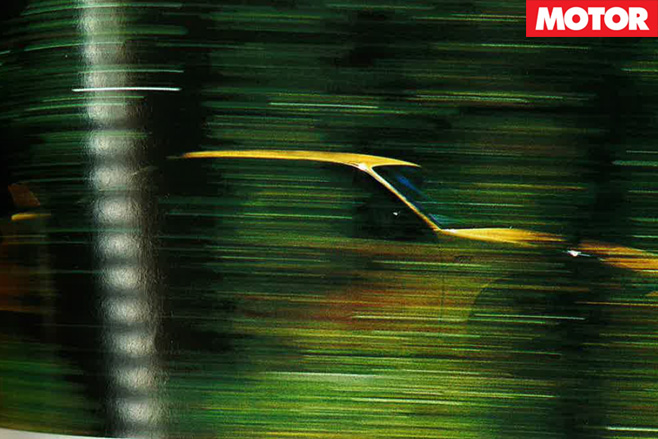
I’m waiting for the brakes to fade. They don’t. I’m waiting for the middle pedal to go like marshmallow. It doesn’t. I’m waiting for the rear to break away, but the surprising ease with which oversteer can be controlled means it stays on line.
Equally unexpected is the way the blueprinted stroker doesn’t wane near the redline. The new exhaust enables it to breathe much better, so now there’s huff to go with the puff. Pity the GTS we featured in PCOTY didn’t feel this tight and vigorous because, aside from the exhaust, it’s mechanically identical to the Winged Thing.
At the bottom of the hill I wait for the pilot at the controls of Godzilla to tell me he had the measure of the Holden. “I was going as hard as I felt I could,” says a stunned Barry Lake. “The HSV just looked so fluid through the turns and pulled away on exits quicker than I imagined it could.”
One stretch of loopy road and one hard run doesn’t categorically make the Holden a better car, but its torque advantage is mammoth. Simply, there’s no substitute for cubes and what’s why the HSV kick the Nissan’s butt every time low down. The HSV has so much grunt it gives adequate acceleration in sixth gear at 100km/h on the highway with the tacho needle struggling to flicker past 1500rpm.
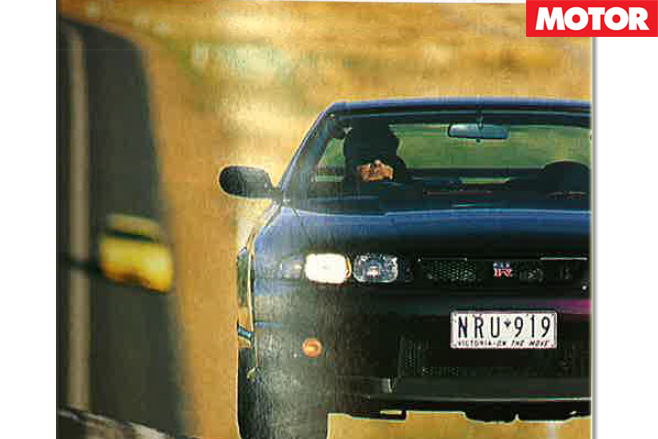
Power is another matter. The Holden’s slight edge in weight/power ratio is purely academic, as we discover heading up the mountain minutes later. Godzilla is just awesome on the climb. The steepness of the ascent means engines work harder, so consequently rev higher and put Godzilla in its preferred territory. It revels in it, having no peer as it scorches up the 14km mountain run.
The first corner is a tight but sweeping right-hander. Concerned by your entry speed, you back off, the wastegate lightly fluttering. Still too quick, perhaps, but too late to do anything about it. Godzilla eats the corner without so much as a squeal from the tyres or even a minute change in body attitude. Encouraged, the next corner is taken ever harder and again the brain is left scrambled by the lack of fuss from the chassis. It is like a train on rails.
The next arc is a hairpin. A slow, busy, clumsy first gear affair. Bury the right foot and feel the sophisticated, unintelligible torque split software do its things as it feeds power to the front wheels and cannons the GT-R out of there. The propulsion happens with the quickness and efficiency on an assasin’s blow. See you at the top – on my second cigarette – GTS-R.
The growl on the in-line six in anger combined with the gush of the swirling turbo rotors creates a goose-bump staccato. The flexing of the aluminium bonnet in your bottom line of vision as the stiff front skips over bumps convinces you, just for a moment, that this is a race car.
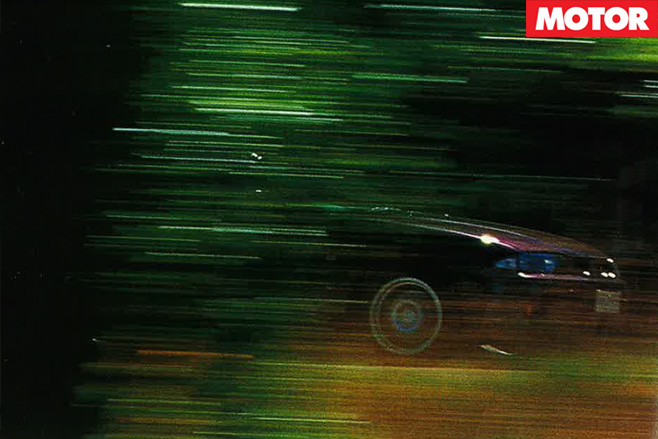
The short-throw gear changes are precise and almost impossible to screw-up – unlike the HSV’s trademark long and notchy throws. The GT-R encourages a degree of driver confidence like no other car we’ve driven.
So faithful, so communicative and so hugely capable is the handling that the Bridgestone Expedia 245/45 ZR17 rubber at each post seems magnetised to the tarmac. Power oversteer makes you think it’s rear-drive. Fantastic. Gimme more. Please.
All of a sudden $190,000 doesn’t sound like a hefty price to pay for something that makes a Porsche 911 Turbo feel spiteful by comparison.
Straight-line acceleration from a standstill may fall short of the 911 Turbo, but it’s still mighty impressive. As fate would have it, we strap the Correvit to both the GT-R and GTS-R while they’re on full tanks, yet both manage excellent runs.
Four-wheel drive cars are the hardest to launch off the line because if the clutch isn’t dropped at near maximum revs they boy, losing precious tenths. The trade-off is clutches may burn-out after such brutal treatment.

The hefty HSV, made more hefty with 75 litres of PULP on board, is beaten but not disgraced with 6.24sec and 14.33sec at 152.4km/h. A high-13 isn’t out of reach.
The variance in performance is generally reflective of the difference between these two great muscle cars. Both are quick, both point well, handle sensationally, grip tenaciously…it’s just that Godzilla does all those things with a higher degree of punch and polish. With its lightweight aluminium body panels, brick-like body, sharp steering and lightning quick gearshifts, it’s more dedicated to delivering the ultimate in performance.
Five years on little has changed with this pair. The Nissan still holds the edge, but Australia’s most potent production Commodore has closed the gap. They’re two very special cars, arguably the best value-for-money sports machines in their respective classes, in the world.
We shall remember them.
SPECS
| u00a0 | NISSAN SKYLINE GT-R | HSV GTS-Ru00a0 |
| Engine | Six in-line with twin turbochargers | Eight, in vee |
| Compression | 8.5:1 | 8.5:1 |
| Power | 206kW @ 6800rpm | 226kW @ 4800rpm |
| Torque | 368Nm @ 4400rpm | 507Nm @ 3500rpm |
| Transmission type | Five-speed manual | Six-speed manualu00a0 |
| Kerb Weight | 1540kg | 1619kgu00a0 |
| L/W/H | 4675/1780/1360mm | 4855/1782/1418mmu00a0 |
| Steering | Power-assisted rack and pinion | Power-assisted rack and pinion |
| Suspension | Independent by multiple links with coil springs, dampers and anti-roll bar(f/r) | Independent by Macpherson struts with coil springs and anti-roll bar(f), Independent by by semi-trailing arms with coil springs and anti-roll bar |
| Brakes | Ventillated 324mm discs(f), 300mm discs(r) (brembo) | Ventillated 330mm discs(f/r) |
| Wheels | Alloy 17 x 9 JJ80 | Alloy 17 x 8 |
| Tyres | Bridgestone Expedia S-07 245/45ZR17 | Bridgestone Expedia S-01 235/45ZR17 |
| List price/price as tested | Approx $190,000 | $76,000/$86,500 |
| Options | None | HSV optimised Engine package |

